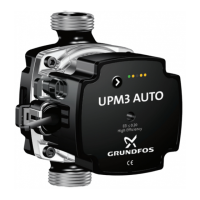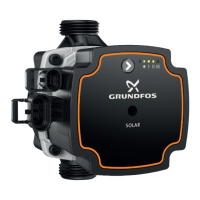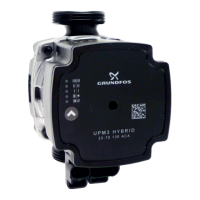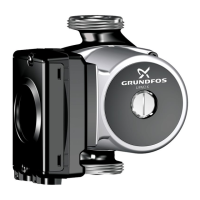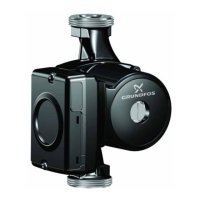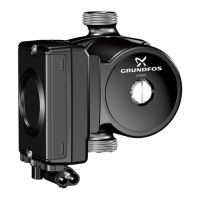Pump control in heating systems
The heating required in a building varies greatly during the
day due to changing outdoor temperatures, solar radiation
and heat emanating from people, electric appliances, and
others. In addition, the need for heating may vary from
one section of the building to another and the thermostatic
valves of some radiators may have been turned down by
the users. An uncontrolled pump will produce a too high
differential pressure when the heat demand and flow are
low.
Possible consequences:
• too high energy consumption
• irregular control of the system
• noise in thermostatic radiator valves and similar
fittings.
Grundfos UPM3 HYBRID and UPM3 AUTO automatically
control the differential pressure by adjusting the pump
performance to the actual heat demand, without the use
of external components.
Advantages of pump control
In Grundfos UPM3 HYBRID and UPM3 AUTO pump
control is effected by adapting the differential pressure to
the flow (proportional-pressure and constant-pressure
control). Contrary to an uncontrolled pump, a constant-
pressure-controlled pump keeps the differential pressure
constant. A proportional-pressure-controlled pump
reduces the differential pressure as a result of falling heat
demand.
For example:
If the heat demand falls, for instance, due to solar
radiation, the thermostatic radiator valves will close, and,
for the uncontrolled pump, the flow resistance of the
system will rise, for instance from A1 to A2.
In a heating system with an uncontrolled pump, this
situation will cause a pressure rise in the system by ΔH
1
.
TM060857
Uncontrolled pump
In a system with a proportional-pressure-controlled pump,
operated in the proportional pressure mode the pressure
will be reduced by ΔH
2
and result in reduced energy
consumption.
TM060858
Pump operated in proportional-pressure control mode
In a system with an uncontrolled pump, a pressure rise
will often cause flow-generated noise in the thermostatic
radiator valves. This noise will be reduced considerably
with proportional pressure control.
AUTO
ADAPT
Grundfos holds a patent for AUTO
ADAPT
since 1995. With
AUTO
ADAPT
, the control curve is automatically adapted to
the actual requirements of the respective application.
If you select AUTO
ADAPT
, the pump starts with the
medium proportional or constant control curve and runs
on this curve as long as a new curve will be adapted.
The AUTO
ADAPT
proportional pressure functionality is well
known from millions of installed Grundfos trade pumps as
ALPHA2 or MAGNA. The AUTO
ADAPT
setting continually
analyses and finds the setting where optimal comfort
meets minimal energy consumption. It automatically
delivers perfect comfort at the lowest possible energy
level. It adapts to the requirements of the heating system
before reaching the maximum pump curve and allows the
pump to adjust the proportional pressure or constant
pressure curve both up and down.
Advantages of AUTO
ADAPT
• Easy installation
• Automatic setting
• Demand-controlled operations
• Optimum comfort
• Energy savings
• Reduced CO
2
emissions.
Constant pressure at all load conditions is essential for
how well the thermostatic valves can control the heat
emission from the radiators. It is a well-known fact that
optimum pump control in a two-pipe heating system with
thermostatic radiator valves is best obtained by controlling
pump pressure on a proportional pressure curve. In
under-floor heating or one-pipe systems it might be better
to use constant pressure control. However, predicting the
best position in real-life applications is rather difficult,
because the optimum position depends on correlated
factors such as the size of the heating system, the boiler
type, the load condition, etc. This is where AUTO
ADAPT
steps in to ensure that the pump is controlled in an
optimum manner.
UPM3
8
31
Control modes, operating panel and settings
